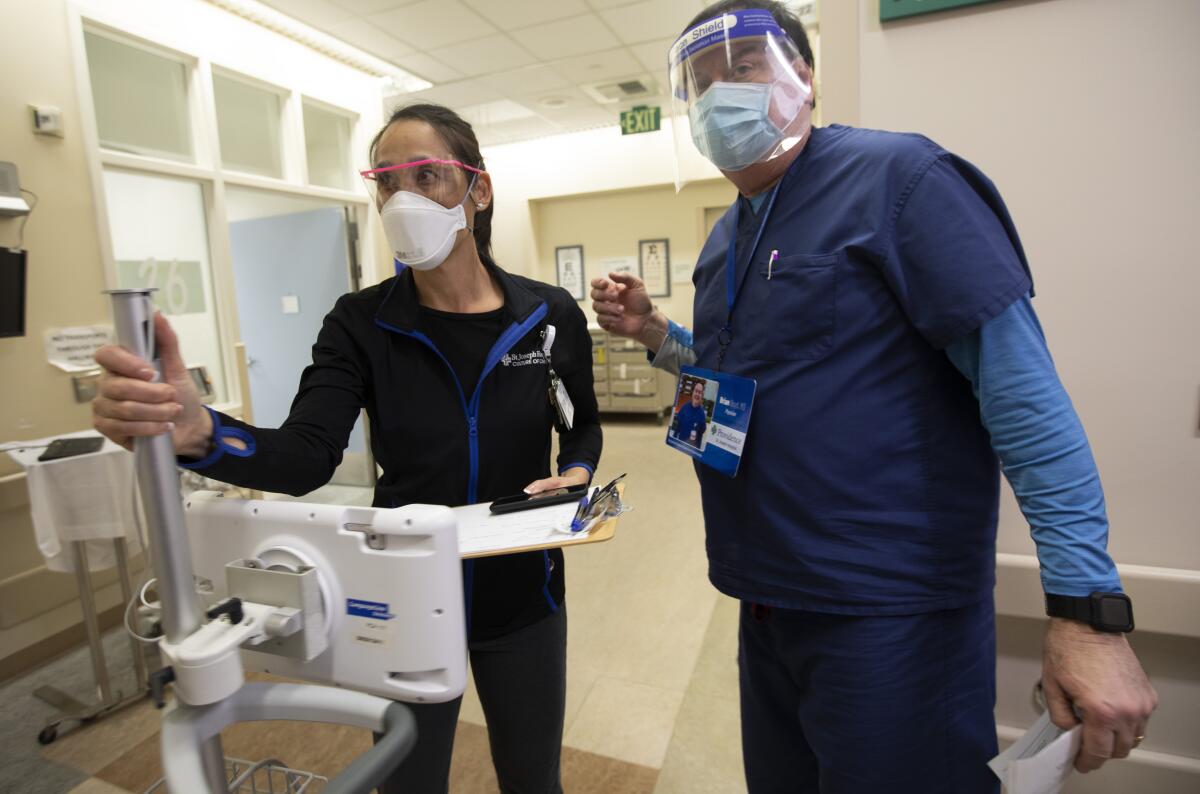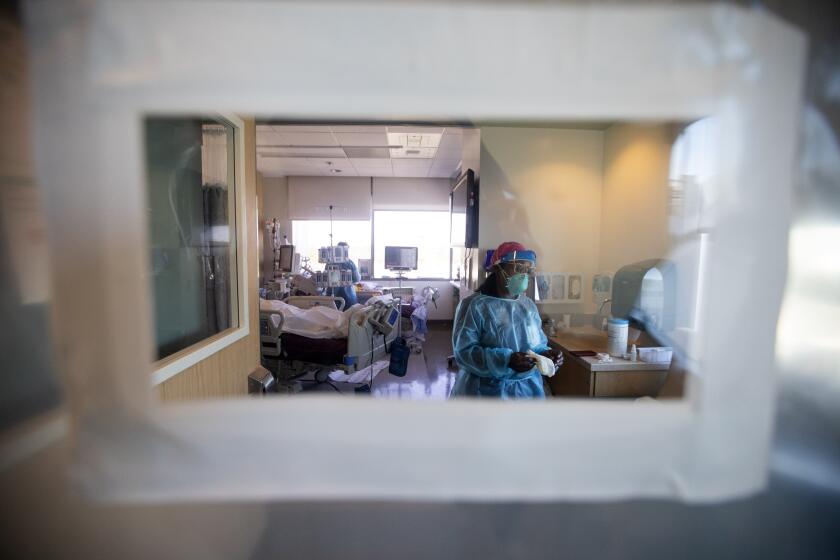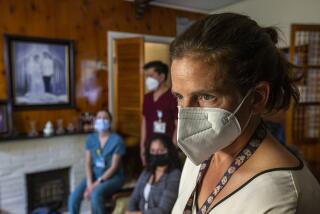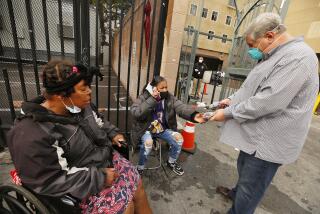Rate of positive coronavirus tests rises in Orange County as it falls in L.A. County

The rate at which coronavirus tests are coming back positive has fallen in the last week in Los Angeles County but is expected to rise further in Orange County.
In Los Angeles County, the so-called positivity rate is 4.4%, Public Health Director Barbara Ferrer said, a decrease from the previous week, when the positive test rate was 6.6%.
But in Orange County, the test positivity rate was 8.3%, said Dr. Regina Chinsio-Kwong, Orange County deputy health officer. And in a sign of potential trouble, the positivity rate is rising in the neediest areas of the county, and was 8.9% on Wednesday, up from 8.6% the day before.
Because the test positivity rate is rising in lower income areas, âmy concern is that weâre going to continue to see the adjusted case rate increase,â Chinsio-Kwong said. âUsually, when you have more positivity, thereâs more spread of the illness to others in the community.
âWe do expect and anticipate that positivity [rates] will continue to rise,â she said. âReally, everybody in our community ... every ZIP Code, needs to take precaution.â
Chinsio-Kwong said she hoped the latest data would cause more residents to wear masks. There is a sizable anti-mask sentiment in Orange County, and a controversy over a local order to wear masks last year resulted in the resignation of the Orange County health officer. Los Angeles County, on the other hand, is one of the few counties in Southern California this summer to require masks in indoor public settings.
âWe are hoping that this information is informing people to make the decision to really protect themselves and their loved ones and to mask up, especially in public areas indoors,â Chinsio-Kwong said. âAnd if youâre in crowded areas outdoors ... you should consider wearing a mask.â
Both counties have comparable vaccination rates: 64.2% of residents of all ages in Orange County have received at least one shot, while 63.1% of L.A. County residents have also received at least one dose.
Still, improvements are especially needed in certain areas. In Orange County, âSan Clemente, Costa Mesa, Huntington Beach, Newport [Beach] all need to work on their vaccination rates,â Chinsio-Kwong said.
Officials in Orange County expressed continued concern about the trajectory of COVID-19 hospitalizations in Californiaâs third most populous county.
There continue to be increases in the amount of time ambulances are waiting to drop off patients at emergency departments, as well as the number of hospitals requesting that ambulances be diverted to neighboring emergency rooms because theyâre already crowded, said Dr. Carl Schultz, medical director for the Orange County Emergency Medical Services Division.
The requests to divert ambulance patients from hospitals was equivalent to 25% of Orange Countyâs hospitals being closed over a 24-hour period, Schultz said.
Nine Orange County hospitals recently reported that it was taking more than an hour for many patients to be offloaded from ambulances to emergency rooms, Schultz said.
âSo the trend is ... not good. Itâs continuing to slowly get worse,â Schultz said. âItâs a steady increase, and weâre starting to make plans for what we will do if this doesnât abate.
âWe now really have to start thinking about what are we going to do if it doesnât get any better.â
For now, however, the level of overcrowding means that people with minor injuries and illnesses must wait longer to receive care. But so far, Schultz said, Orange Countyâs hospitals are still able to provide critically ill people prompt attention.
Hospital crowding is still not as bad as it was last winter, Schultz said. And Orange County is not in a position where officials are urging hospitals to cancel elective, or scheduled, surgeries, something that is either being done or urged by officials in harder hit states such as Florida and Texas.
âWe are a long ways from that,â Schultz said. âOne of the things that might more likely happen if things got worse is that hospitals might reduce the number of elective surgeries that they do.â
The issue with Orange Countyâs hospitals isnât beds or space but medical staff, Schultz said. âBy slightly reducing elective surgeries, it would perhaps free up some staff to be used elsewhere in the hospital,â he said.
Most hospitals in Orange County are functioning close to standard capacity, Schultz said. âSome of them are starting to open up tents to help offload some of the burden on emergency departments.â
As of Tuesday, 495 people with COVID-19 were hospitalized in Orange County, the highest number in nearly six months, as the winter surge was fading, and five times the number from a month ago, when 102 COVID-19 patients were in hospitals on July 10. Still, the recent number is far below the peak of the winter surge, when 2,259 people were hospitalized in Orange Countyâs hospitals.
The hospitals that are hardest hit by crowding tend to be near the countyâs borders. In general, the hospitals in southern Orange County can get crowded as thereâs a relative scarcity of hospitals in that area, and hospitals near the county border in northern Orange County are sometimes crowded with patients coming in from L.A. County.
About 90% of COVID-19 patients in Orange Countyâs hospitals are not vaccinated, Supervisor Katrina Foley said. In July, all children hospitalized for COVID-19 in Orange County were not vaccinated, Chinsio-Kwong said.
There were 27 children hospitalized in July at Childrenâs Hospital of Orange County who had COVID-19, Dr. Matthew Zahn, medical director of the countyâs Communicable Disease Control Division, said Monday.
The best way to protect children under 12, who are too young to be immunized, is to get everyone in the family vaccinated as soon as possible, Chinsio-Kwong said. And for children returning to school, she said, they will be required to wear a mask in indoor settings.
âEverybody needs to universally mask indoorsâ at schools, she said.
Foley this week also expressed concern over a recent diagnosis of COVID-19 psychosis in an Orange County teenager who had been diagnosed with multisystem inflammatory syndrome in children, as reported earlier this week by KCBS-TV. A report published in the journal JAMA Neurology earlier this year said that in a study of 1,695 patients age 21 or younger who were hospitalized for MIS-C, 365 had neurological problems. Of them, 43 developed life-threatening disorders, and 11 died.
The syndrome is a rare condition associated with COVID-19 that can develop in children and cause different parts of the body to become inflamed, such as the heart, lungs, kidneys, brain, skin, eyes or gastrointestinal organs, according to the U.S. Centers for Disease Control and Prevention.
With COVID-19-induced psychosis, the child behaves unusually, Chinsio-Kwong said. âThey may see things, hear things, just act very different,â she said, likely related to an inflammation of the brain. âThey may be saying awkward things; they donât know who they are; they donât know who you are.
âIt can be actually very scary for parents,â Chinsio-Kwong said, and requires immediate, specialized health treatment.
Although MIS-C is rare, the fact that 22% of young people who did get MIS-C had neurological problems in this study was concerning, Chinsio-Kwong said. The child could have lasting health problems, she said. The study, however, did point out that neurological problems in hospitalized children and adolescents were mostly transient.
One-third of COVID-19 survivors were diagnosed with a psychiatric or neurological condition within six months of being infected with the coronavirus.
More to Read
Sign up for Essential California
The most important California stories and recommendations in your inbox every morning.
You may occasionally receive promotional content from the Los Angeles Times.













